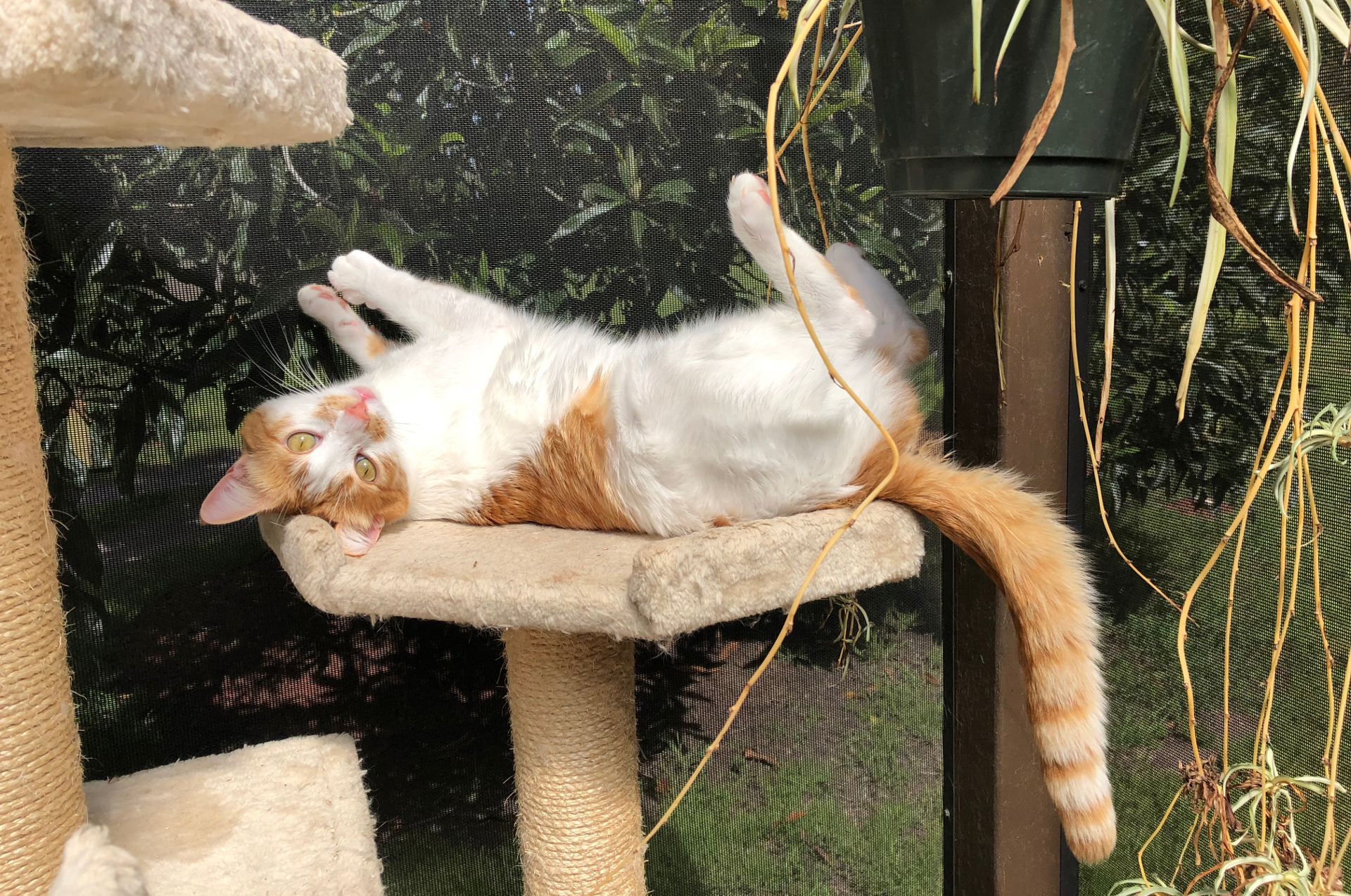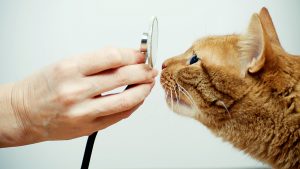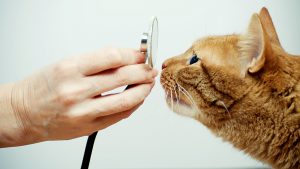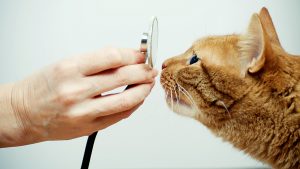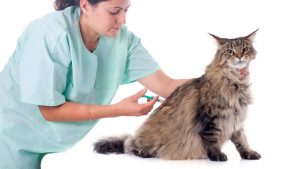Provided by the Cornell Feline Health Center, Cornell University
What is a zoonotic disease?
While most feline infectious diseases affect only cats, and most human infectious diseases affect only humans, it is important to be aware that some of these diseases-called zoonotic diseases-can be transmitted between cats and people. You are much more likely to contract ailments from other humans than you are from your cat. However, simple precautions, common sense, and good hygiene, including careful handling of litter boxes and treating cats with fleas and other parasites, can further reduce the risk of zoonotic disease.
How are zoonotic diseases transmitted?
Transmission of a zoonotic disease can potentially occur when a person comes into direct contact with secretions or excretions-such as saliva or feces-from an infected cat. Additionally, a disease may be contracted through contact with water or food that has been contaminated by an infected cat. Many zoonotic diseases can be transmitted from fleas or ticks (called vectors) to a person or a cat from another animal.
Who is at risk?
Most zoonotic diseases pose minimal threat; however, some humans are particularly at risk. Those with immature or weakened immune systems, such as infants, individuals with acquired immunodeficiency syndrome (AIDS), the elderly, and people undergoing cancer therapy, are more susceptible to zoonotic infections than others.
What are some common zoonotic diseases?
Bacterial Infections
Cat-scratch disease, also called bartonellosis, is by far the most common zoonotic disease associated with cats. Approximately 25,000 people are diagnosed every year in the United States. Cat-scratch disease can occur when a person is bitten or scratched by an infected cat. Fleas may also play a role in the transmission of infection. People with cat-scratch disease usually have swollen lymph nodes, especially around the head, neck, and upper limbs. They may also experience fever, headache, sore muscles and joints, fatigue, and poor appetite. Healthy adults generally recover with no lasting effects, but it may take several months for the disease to go away completely. People with compromised immune systems may suffer more severe, even fatal, consequences.
Some healthy cats are continuously or intermittently infected with cat-scratch disease bacteria, but antibiotics do not reliably cure infection in these cats and are not currently recommended. However, avoiding scratches and bites (for example, by not allowing children to play roughly with cats), controlling fleas, and keeping cats indoors all reduce the risk of cat-scratch disease. Because most cases of cat-scratch disease result from contact with kittens, immunosuppressed people should avoid such contact.
Salmonellosis, another common bacterial disease, can cause diarrhea, fever, and stomach pain beginning one to three days after infection. Salmonellosis usually resolves on its own. However, some people require medical attention because the diarrhea is severe or the infection is affecting other organs. People usually get salmonellosis by eating contaminated food, such as undercooked chicken or eggs. However, cats and other animals-even those that appear healthy-can carry and pass salmonella bacteria in their stool. Salmonella bacteria are more commonly harbored by cats that feed on raw meat or wild birds and animals. Feline infection can be prevented by keeping cats indoors and feeding them cooked or commercially processed food. Human infection can be prevented by wearing gloves and washing hands thoroughly after cleaning litter boxes (especially if used by a cat with diarrhea).
Parasitic Infections
Fleas are the most common external parasite of cats. While fleas cannot thrive on humans, their bites can cause itching and inflammation. Fleas may also serve as vectors for cat-scratch and other zoonotic diseases. Flea-infested cats may become infected with tapeworms from fleas ingested while grooming. Children, albeit rarely, can also become infected with tapeworms from inadvertently ingesting fleas.
Fungal Infections
Ringworm is not caused by a worm at all; it is a skin infection caused by a group of fungi. Infected cats most often come from environments housing large numbers of animals. In cats, ringworm appears as a dry, gray, scaly patch on the skin. In humans, ringworm often appears as a round, red, itchy lesion with a ring of scale around the edge. Ringworm is transmitted by contact with an infected animal’s skin or fur, either directly or from a contaminated environment. Infected cats continuously drop fungal spores from their skin and fur; these spores, which remain capable of causing infection for many months, are difficult to eradicate from a household. Children are particularly at risk of infection. To reduce environmental contamination, confine infected cats to one room until they are free of infection; then thoroughly clean and disinfect the household.
Protozoal Infections
Protozoans are single-celled organisms. The three most common protozoal diseases in cats and humans are cryptosporidiosis, giardiasis, and toxoplasmosis. Cryptosporidiosis and giardiasis can cause diarrhea in both cats and people, who usually become infected by a common source-for example, contaminated water-not by each other. To prevent the spread of infection, schedule annual fecal examinations for your cats, and medicate infected cats as directed by your veterinarian. Other preventive measures include wearing gloves while handling feces-contaminated material, washing hands afterwards, and boiling or filtering any surface water used for drinking.
Toxoplasmosis is caused by the parasitic protozoan Toxolasma gondii. People with weakened immune systems, or infants whose mothers are infected during pregnancy, can develop severe illness. People commonly become infected by eating undercooked or raw meat, or by inadvertently consuming contaminated soil on unwashed or undercooked vegetables. Unfortunately, pregnant women or immunosuppressed individuals are often mistakenly advised to remove cats from the household to reduce the risk of toxoplasmosis. However, people are highly unlikely to become infected from direct contact with their cats.
Cats can become infected by eating infected rodents, birds, or anything contaminated with feces from another infected cat. An infected cat can shed the parasite in its feces for up to two weeks. The parasite must then mature for one to five days before it becomes capable of causing infection. However, it can persist in the environment for many months and continue to contaminate soil, water, gardens, sandboxes, or any place where an infected cat has defecated.
Basic hygiene can prevent toxoplasmosis. Wear gloves when handling potentially contaminated material (for example, when gardening or handling raw meat), and be sure to wash your hands afterwards. Avoid eating undercooked meat, and thoroughly wash fruit and vegetables before eating. Surface water should be boiled or filtered prior to drinking, and children’s sandboxes should be covered when not in use to prevent wandering cats from defecating in them. Scoop litter boxes daily while wearing gloves, and wash your hands afterwards. Pregnant women or immunosuppressed individuals are safest when other household members clean the litter box.
Viral Infections
Most viruses infect only their natural host species. Human viruses, like those that cause the common cold, infect only humans, while feline immunodeficiency virus, feline infectious peritonitis virus, and feline leukemia virus infect only cats. However, one virus that can be passed from cats to humans is rabies, a viral disease resulting from the bite of an infected animal. Cats are highly susceptible to rabies, which attacks the central nervous system, causing a variety of signs. Rabies is almost always fatal. In people, rabies infections usually occur when an infected animal bites a person. In order to protect human health, rabies vaccination of cats is required by law in many areas. Even if your cat is kept indoors, it is important to keep rabies vaccines current because cats occasionally escape outdoors, and because rabid animals such as bats and raccoons occasionally enter houses. To further reduce your risk of rabies, avoid contact with wildlife and stray animals. See a doctor immediately if you have been bitten by an animal.
What can I do to protect my cat and myself?
Common sense and good hygiene will go a long way toward keeping you, your family, and your cat free of zoonotic diseases. Here are a few simple precautions:







